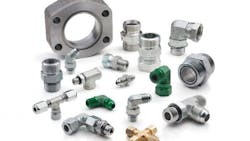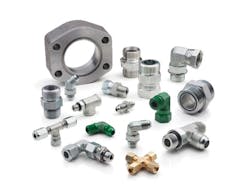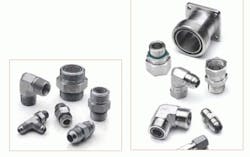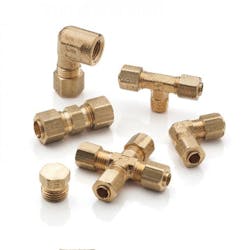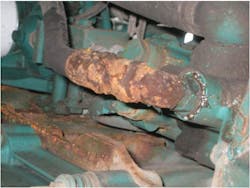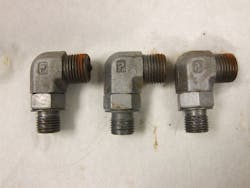To ensure a leak-free connection, five factors must be carefully considered in selecting the best fitting style and material for an application. These include Size, Temperature, Application, Media, and Pressure (STAMP). The acronym STAMP is an easy tool to use for determining the proper fitting and material. Although this article deals primarily with determining what is the right fitting material for an application, all five STAMP parameter considerations are important in making the best fitting material and type determination.
Size: The tube OD and wall thickness must be considered for all tube fittings. With most tube end types, limitations exist with respect to tube wall thickness. Flare type fittings typically have a maximum wall limitation. Flareless bite-type fittings generally have a minimum wall limitation. System pressure, flow, temperature, and the service environment also affect size.
Temperature: The system and environment temperature in which hydraulic tube fittings can operate depends on the type of material, protective plating or coating, and the seal material.
Application: System environment — such as vibration, pressure spikes, and external thermal and mechanical load — also influences fitting material selection and whether a protective plating or coating is required.
Media: The type of fluid being conveyed also directly affects fitting and seal material selection.
Pressure: Rated dynamic pressure of the fitting should be equal to or higher than the system pressure. Industrial tube fittings usually are rated at a 4:1 design factor — the dynamic working pressure is 1⁄4 of the maximum hydrostatic failure pressure. The 4:1 design factor applies to “normal” operating conditions with moderate mechanical and hydraulic shocks and vibration. Some applications can use a 3:1 design factor where vibration, thermal load, mechanical, and hydraulic shocks are not significant.
Fitting purpose and construction
Two general fitting categories are based on geometry — straights and shapes. Straights are typically machined from cold drawn, hexagonal, or sometimes round bar stock. Shapes are typically forged or brazed. Because forgings are single-piece construction, they have no potential leak paths, which can occur with a two-piece brazed fitting. Also, forged fittings are normally stronger because they are not limited by the strength of the brazed joint. This added strength typically produces longer life and higher-pressure ratings than brazed fittings.
Some manufacturers prefer brazed fittings because of the large number of configurations that can be made with little investment in capital equipment. As a result, brazed fittings are usually offered at a lower price to the user.
Material selection considerations
Hydraulic fitting materials must have adequate strength and corrosion resistance to safely handle the high pressures characteristic of hydraulic systems. In addition, the fitting material must resist rust and corrosion from the different media inside and outside of the vessel. Other selection factors include cost and outside environmental conditions.
Generally, metal fittings are used in most hydraulic systems due to their high pressure ratings. Plastics have naturally higher resistance to corrosion than metals but have lower strength and durability, making them less suitable for hydraulic systems.
Carbon steel is durable, strong, and has a high resistance to heat, with a temperature range of –65° to 500°F (–54° to 260°C). An alloy of iron and carbon, it is typically alloyed with other metals to improve strength, toughness, and other properties.
External protective coatings such as electroplated cadmium, zinc, and zinc phosphate are applied to carbon steel fittings to extend their service life in corrosive environments. However, in the past decade, cadmium is no longer accepted by most industries due to environmental considerations. Cadmium and zinc corrode sacrificially, protecting the steel substrate from normal atmospheric rusting due to the common presence of oxygen, moisture, and acidic gases. However, they are rapidly attacked by many fluids — including those containing acidic hydrogen, reactive fluorine, chlorine, bromine, iodine, and nitrogen. Zinc-nickel external coating provides enhanced carbon steel protection in ASTM B117 salt spray testing and in fertilizer (urea) applications.
Stainless steel fittings, along with brass fittings in low-pressure applications, are viable options. In applications where low toxicity and low corrosion are required — as in food or beverage applications — steel coated with any form of zinc or other protective coatings is not recommended.
Fluid pressure (both operating and peak) must also be considered. Allowable design pressure ratings for carbon steel fittings are rated up to 18,000 psi, depending on the steel grade or alloy. Carbon steel fittings are widely used in industrial, construction, and agricultural equipment because of the requirement for high pressure, high strength, and low cost.
Stainless steel is strong and has excellent chemical and corrosion resistance. Its temperature range is –425° to 1200°F (–254° to 649°C). Stainless steel is an alloy of steel that contains more than 10.5% chromium. It has the strength and durability of steel while also providing excellent corrosion resistance, making it the most suitable fitting material for hydraulic applications where the fluid or surrounding environment is corrosive. Stainless steel’s toughness is significantly better than carbon steel’s at low temperature.
Industrial stainless-steel fittings are often rated to 10,000 psi. Specially designed stainless steel fittings can have pressure ratings as high as 20,000 psi.
Typically, stainless steel fittings are more expensive than those made from other materials. However, many applications require its corrosion resistance — oil, gas, and offshore equipment; chemical processing; food manufacturing; medical and instrumentation; agricultural fertilizer; and marine applications.
Brass offers moderate strength and toughness, and good corrosion resistance with good ductility at high temperatures. Its temperature range is –325° to 400° F (–198° to 204° C). An alloy primarily of copper and zinc, brass is typically used for smaller compression and threaded fittings because of its high machinability.
Brass is not recommended for temperatures exceeding 400° F because it becomes soft and exhibits lower strength at these temperatures. Brass can accommodate pressures to 3000 psi depending on the design and size of the fitting. However, most brass fitting applications are rated for lower pressures.
Brass fitting straights, like steel and stainless steel, are machined from hexagonal bar stock, whereas fitting shapes are typically forged. Brazed construction, however, affords a wider variety of configurations.
Aluminum fittings can handle higher pressure than brass and reduce weight when an application has a moderate pressure rating. An anodized external finish improves corrosion resistance, as well as makes the surface harder for wear and abrasion resistance. Media compatibility of aluminum is very good.
Aluminum fitting straights are generally machined from hexagonal bar stock; shapes are normally forged.
Aluminum fittings are used where light weight is important — aerospace, military and automotive. They are widely used with plastic and aluminum tubing.
In conclusion
There have always been individual industry traditions in fitting material selection and use. Simply, each industry tends to continue using the same fitting materials for aftermarket field compatibility and to ensure fitting interchangeability. That said, for new equipment design, OEMs should consider innovative new materials and explore different options that use the latest technologies to improve tube fitting performance.
Le Yu is the Core Engineering Manager for the Parker Hannifin Corp., Fluid Connectors Group, Tube Fittings Div., Columbus. Contact him at (614) 279-7070 or [email protected], or visit www.parker.com/tfd.
Enhanced corrosion protection for extended carbon steel fitting life
Early corrosion on mobile equipment has become a major industry problem with the preference to use less expensive carbon steel fittings in place of more expensive stainless steel. In fluid power, corrosion is harmful to a hydraulic system as the deterioration of metal can cause system contamination, potential leaks, fitting connection problems, aesthetic quality concerns, maintenance difficulty, along with negative effects on adjacent components. Hydraulic hoses protect the metal reinforcement of the hose by placing a rubber cover on top of the reinforcement. But metal tube fitting adapters and hose fittings must rely on coatings or plating for protection. Figure 1 illustrates the damage corrosion can do in just one year of service without proper plating protection.
Corrosion occurs when the base metal begins to oxidize, so the challenge is to prevent oxidation from starting by protecting the base metal, while still having an adaptor or hose fitting solution that will function properly and is not cost prohibitive.
The current SAE/ISO industry standard is to not see more than 5% of red rust over 72 hours of ASTM B117 salt spray testing. Many carbon steel fittings in the market test right at, or slightly above this requirement.
The XTR corrosion solution from Parker has been shown to improve plating performance by successfully resisting urea for 500 hours. It also works well against salt spray as shown in Figure 2- Independent Salt Spray Test.
Figure 3 shows that the XTR coating has held up to 2040 salt spray test hours without seeing excessive material degradation. The XTR corrosion solution used the highest plating quality available today. OEMs see cost advantages because they can eliminate extra supplies and labor spent on painting or poly-coating processes in an effort to hold off early corrosion of their equipment in the field.
Future formulations of the XTR plating solution might be designed to completely eliminate all environmentally hazardous chemicals from the plating, but still provide robust protection.
About the Author
Le Yu
Parker Hannifin Corp.

Leaders relevant to this article:
